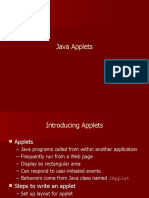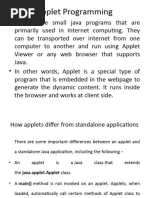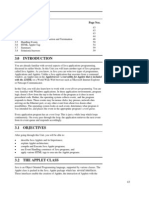Chapter11 JavaApplets
Uploaded by
pfidalChapter11 JavaApplets
Uploaded by
pfidalJava applets
M. L. Liu
01/13/24 Distributed Computing, M. L. Liu 1
Introduction
Java applets are one of three kinds of Java
programs:
An application is a standalone program that can be
invoked from the command line.
An applet is a program that runs in the context of a
browser session.
A servlet is a program that is invoked on demand on a
server program and that runs in the context of a web
server process.
01/13/24 Distributed Computing, M. L. Liu 2
Applets, web page, client, server
Applets are programs stored on a web server, similar to web pages.
When an applet is referred to in a web page that has been fetched and
processed by a browser, the browser generates a request to fetch (or
download) the applet program, then executes the program in the browser’s
execution context, on the client host.
s e r ve r ho s t
br o w s e r ho s t
we b s e rv e r
bro ws e r
re qe u s t fo r
m y W e bPa g e .h tm l
m y W e bPa g e .h tm l
m y W e bPa g e .h tm l H e llo W o rld.cla s s
... re qu e s t fo r
< a pple t co de = H e llo W o rld.cla s s < /a pple t> H e llo W o rldcla s s
...
H e llo W o rld.cla s s H e llo W o rld.cla s s
01/13/24 Distributed Computing, M. L. Liu 3
Applet Execution - 1
An applet program is a written as a subclass of the
java.Applet class or the javax.swing.Japplet class.
There is no main method: you must override the
start method. Applet objects uses AWT for graphics.
JApplet uses SWING.
It is a Grapics object that runs in a Thread object, so
every applet can perform graphics, and runs in
parallel to the browser process.
01/13/24 Distributed Computing, M. L. Liu 4
Applet Execution
When the applet is loaded, these methods are automatically
invoked in order:
the init( ) method is invoked by the Java Virtual Machine.
The start( ) method
The paint( ) method.
The applet is now running and rendered on the web page.
You program the start( ) method and the paint( ) method for
your application, and invoke a repaint call to re-render the
graphics, if necessary.
At the end of the execution, the stop( ) method is invoked,
followed by the destry( ) method to deallocate the applet’s
resources.
01/13/24 Distributed Computing, M. L. Liu 5
Applet Security
http://java.sun.com/docs/books/tutorial/applet/overview/
For security reasons, applets that are loaded over
the network have several restrictions.
an applet cannot ordinarily read or write files
on the computer that it's executing on.
an applet cannot make network connections
except to the host that it came from.
01/13/24 Distributed Computing, M. L. Liu 6
HTML tags for applets - 1
<APPLET specifies the beginning of the HTML applet code
CODE="demoxx.class" is the actual name of the applet (usually a
'class' file)
CODEBASE="demos/" is the location of the applet (relative as here,
or a full URL)
NAME="smily" the name you want to give to this instance of the
applet on this page
WIDTH="100" the physical width of the applet on your page
HEIGHT="50" the physical height of the applet on your page
ALIGN="Top" where to align the applet within its page space (top,
bottom, center)
01/13/24 Distributed Computing, M. L. Liu 7
HTML tags for applets - 2
<PARAM specifies a parameter that can be passed to the applet
NAME=“name1" the name known internally by the applet in order to
receive this parameter
VALUE="000000" the value you want to pass for this parameter
> end of this parameter
<PARAM specifies a parameter that can be passed to the applet (applet
specific)
NAME=“name2" the name known internally by the applet in order to
receive this parameter
VALUE="ffffff" the value you want to pass for this parameter
> end of this parameter
</APPLET> specifies the end of the HTML applet code
01/13/24 Distributed Computing, M. L. Liu 8
The HelloWorld Applet
<HTML> public void paint(Graphics g){
<BODY> final int FONT_SIZE = 42;
<APPLET code=hello.class width=900
height=300> Font font = new
</APPLET> Font("Serif", Font.BOLD,
</BODY> FONT_SIZE);
</HTML>
// set font, and color and display
// applet to display a message in a message on
window // the screen at position 250,150
import java.awt.*; g.setFont(font);
import java.applet.*; g.setColor(Color.blue);
// The message in the next line is
public class hello extends Applet{ the one you will see
public void init( ){ g.drawString("Hello,
world!",250,150);
setBackground(Color.yellow); }
} }
01/13/24 Distributed Computing, M. L. Liu 9
Advanced Applets
You can use threads in an applet.
You can make socket calls in an applet, subject to the security constraints.
S e r ve r h o s t C l i e nt ho st
H TTP s e rv e r bro ws e r
a p p le t d o w n lo a d
s erv er Y a llo w e d
c o n n e c tio n r e q u e s t a pple t
f o r b id d e n
H ost X
c o n n e c tio n r e q u e s t
s erv er Z
01/13/24 Distributed Computing, M. L. Liu 10
Proxy server
A proxy server can be used to circumvent the security constraints.
Se r ve r ho s t C l i e nt ho s t
H TTP s e rv e r bro ws e r
ap p let d o w n lo ad
s er v er Y
c o n n ec tio n r eq u es t a pple t
H o st X
c o n n ec tio n r eq u es t
s er v er Z
01/13/24 Distributed Computing, M. L. Liu 11
Summary
An applet is a Java class
Its code is downloaded from a web server
It is run in the browser’s environment on the client host
It is invoked by a browser when it scans a web page and
encounters a class specified with the APPLET tag
For security reason, the execution of an applet is
normally subject to restrictions:
applets cannot access files in the file system on the client host
Applets cannot make network connection exception to the
server host from which it originated
01/13/24 Distributed Computing, M. L. Liu 12
You might also like
- 27-appletprogramming-130815152759-phpapp01No ratings yet27-appletprogramming-130815152759-phpapp0131 pages
- CJT 11-Applets and Advanced Graphics-6X1No ratings yetCJT 11-Applets and Advanced Graphics-6X114 pages
- Object-Oriented Programming: Computer Science Year IINo ratings yetObject-Oriented Programming: Computer Science Year II18 pages
- Java - Applets For Object Oriented ProgrammingNo ratings yetJava - Applets For Object Oriented Programming36 pages
- Introduction To Java 2 Programming: AppletsNo ratings yetIntroduction To Java 2 Programming: Applets18 pages
- Applets: Applet Programs Application ProgramsNo ratings yetApplets: Applet Programs Application Programs21 pages
- Modern Programming Tools and Techniques-I: Lovely Professional University, PunjabNo ratings yetModern Programming Tools and Techniques-I: Lovely Professional University, Punjab44 pages
- Applets: Interactive Feature To Web ApplicationNo ratings yetApplets: Interactive Feature To Web Application36 pages
- Unit-5 cultural Heritage And Performing ArtsNo ratings yetUnit-5 cultural Heritage And Performing Arts60 pages
- Programming Logic and Design: Eighth EditionNo ratings yetProgramming Logic and Design: Eighth Edition35 pages
- The White Angel Djuro Zivkovic instant download100% (2)The White Angel Djuro Zivkovic instant download79 pages
- Microsoft - Certleader.pl 400.rapidshare.2023 Jun 27.by - Brian.176q.vceNo ratings yetMicrosoft - Certleader.pl 400.rapidshare.2023 Jun 27.by - Brian.176q.vce25 pages
- (Calculus New York University) Final Fall 11No ratings yet(Calculus New York University) Final Fall 1114 pages
- Hanuman Chalisa (Hindi, Sanskrit, English, Illustrated)No ratings yetHanuman Chalisa (Hindi, Sanskrit, English, Illustrated)8 pages
- Instant ebooks textbook Check Your English Vocabulary for TOEFL 5th Edition Rawdon Wyatt download all chapters100% (3)Instant ebooks textbook Check Your English Vocabulary for TOEFL 5th Edition Rawdon Wyatt download all chapters40 pages
- Chapter 1.1 Philosophical Perspective of The SelfNo ratings yetChapter 1.1 Philosophical Perspective of The Self69 pages
- 18TH Class - Adjectives of Personality FlashcardsNo ratings yet18TH Class - Adjectives of Personality Flashcards70 pages
- Mathematical Monotheism - THE IMAGE OF GOD (Part 1)No ratings yetMathematical Monotheism - THE IMAGE OF GOD (Part 1)13 pages

























































































